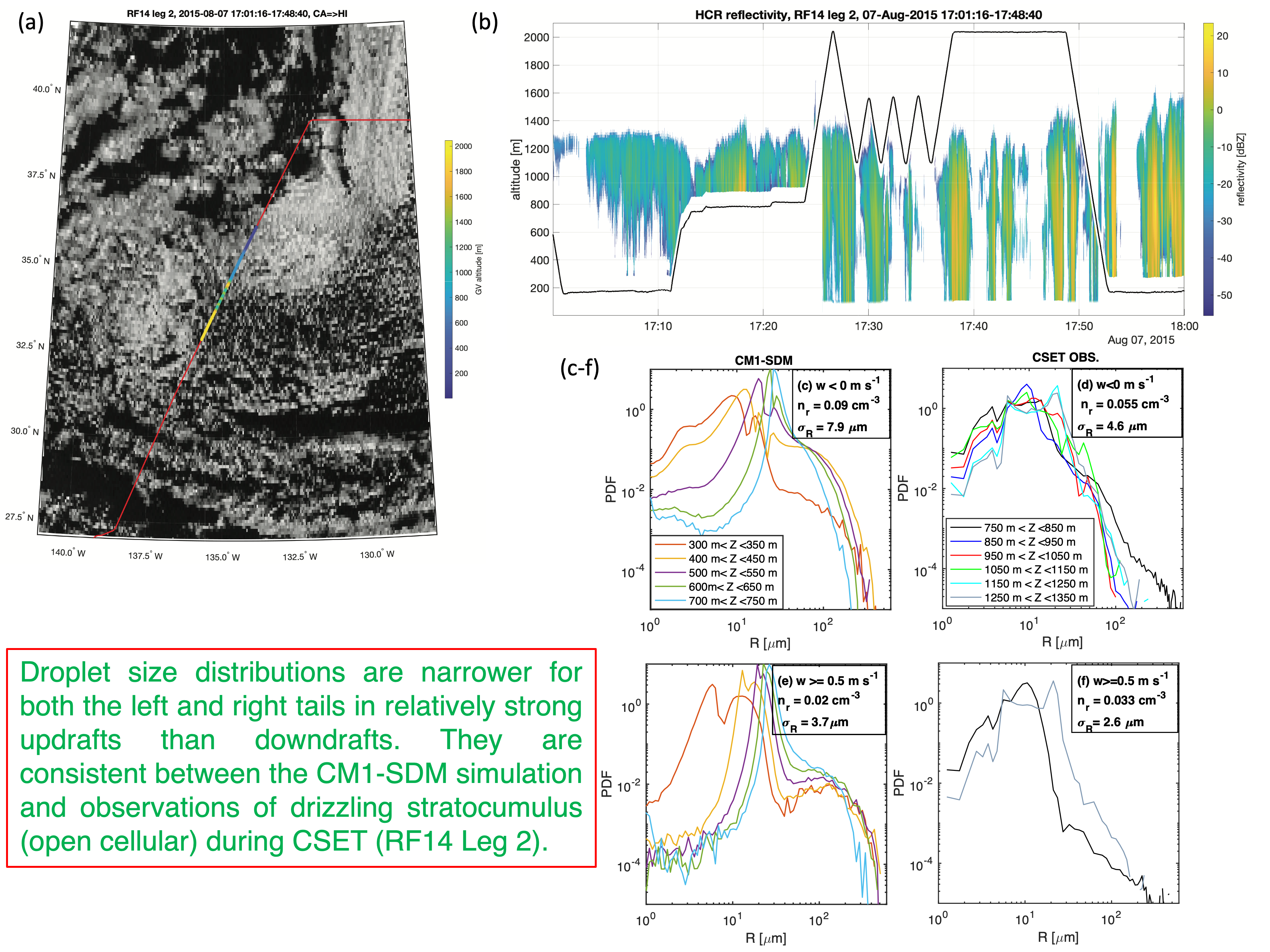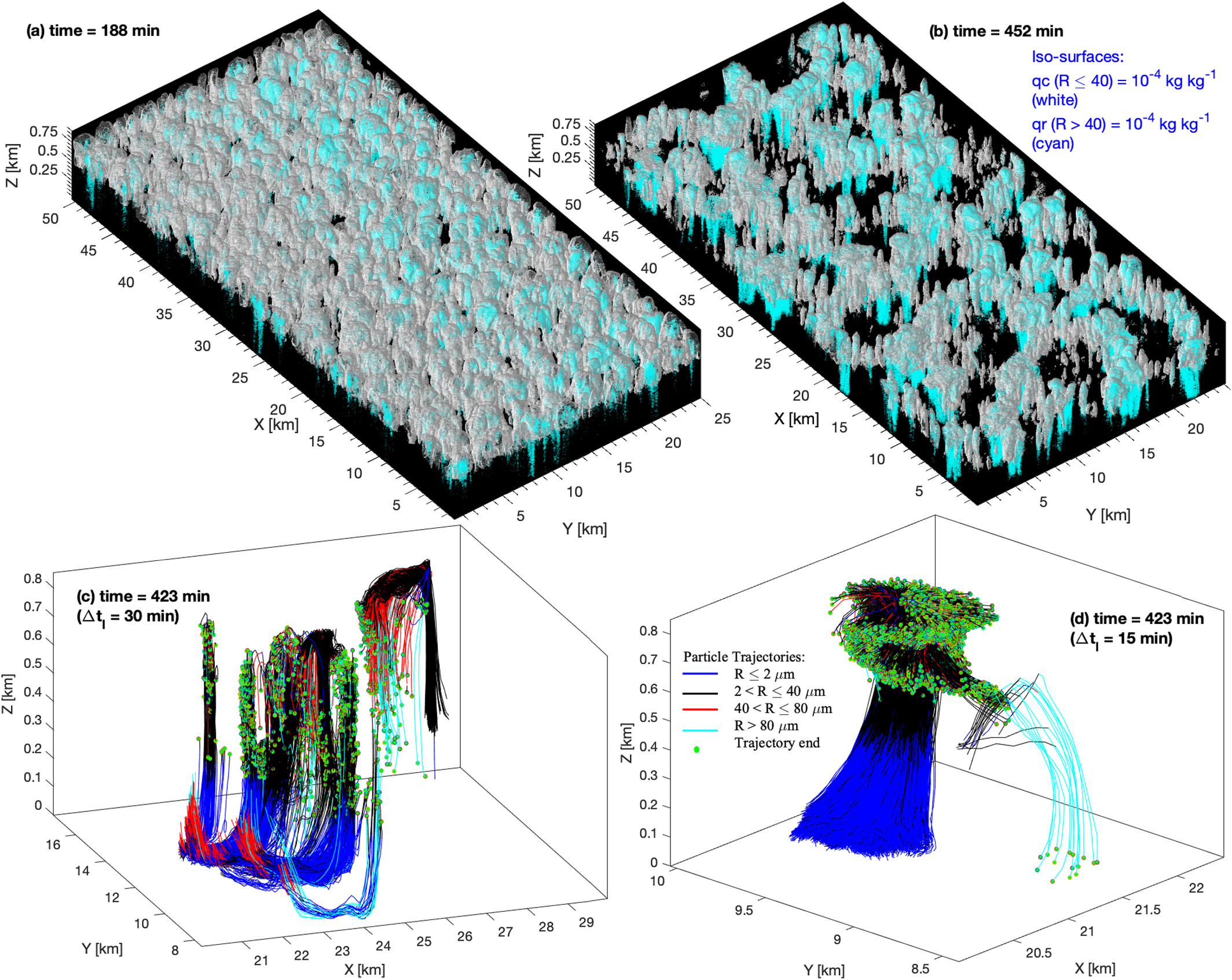Evolution of droplet size distributions during the transition of stratocumulus clouds to open cells
Submitter
Chandrakar, Kamal Kant — NSF National Center for Atmospheric Research
Morrison, Hugh Clifton
— University Corporation for Atmospheric Research
Area of Research
Cloud-Aerosol-Precipitation Interactions
Journal Reference
Chandrakar K, H Morrison, and M Witte. 2022. "Evolution of droplet size distributions during the transition of an ultraclean stratocumulus cloud system to open cell structure: AN LES INVESTIGATION USING LAGRANGIAN MICROPHYSICS." Geophysical Research Letters, 49(17), e2022GL100511, 10.1029/2022GL100511.
Science

Figure 2. (a) GOES-15 visible reflectance and the overlaid flight track (solid lines) showing cloud field structure corresponding to the in situ observations presented from Research Flight 14 Leg 2 during the CSET field campaign. (b) Time-height curtain plot of airborne radar reflectivity. (c-f): Averaged droplet size distributions at different vertical velocity (w) and altitude (Z) ranges during the open cellular phase from a CM1-SDM (left) simulation and measured during CSET (right). See Chandrakar et al. GRL (2022) for details.

Figure 1. (a and b) Iso-surfaces of cloud (qc) and rain water (qr) mixing ratio during the closed- and open-cell phases. (c and d) Sample super-droplet trajectories for time periods (Δtl) of 30 min (c) and 15 min (d) during the open-cell phase. Trajectories in (c) were selected based on a minimum length of 1,000 m and in (d) by a minimum length of 800 m and end radius R > 10 μm, respectively. These trajectories display variability in drop growth history due to turbulent motion in the boundary layer. From journal.
Low-level stratocumulus clouds critically impact Earth's energy budget by reflecting incoming solar radiation and are challenging to represent in climate models due to fine-scale variability in cloud properties driven by turbulent flow. Once the clouds change to an open cellular structure, cloud and drizzle drop sizes and growth differ in upward- and downward-moving branches of large turbulent eddies, with more drizzle formation and greater variation in drop sizes in downward-flow regions.
Impact
A cutting-edge Lagrangian microphysics scheme in a mesoscale large-eddy simulation and observations during the Cloud Systems Evolution in the Trades (CSET) field campaign was used to investigate spatiotemporal variability in droplet size distributions and their impact on the stratocumulus closed-to-open cell transition. The detailed information on in-cloud variability of droplet size distributions and drop lifetime could be useful for subgrid parameterization development in Earth system models.
Summary
A state-of-the-art Lagrangian microphysics scheme was used in a large-eddy simulation to investigate the stratocumulus transition from closed to open cell structure. Processes controlling precipitation development, which is a key to the transition, are analyzed by leveraging unique benefits of Lagrangian microphysics, particularly the ability to track computational drops in the flow. Sufficient time is needed for coalescence growth of cloud drops to drizzle within the updraft-downdraft cycle of large eddies. This favors broad drop size distributions and drizzle growth in downdrafts, where drops are typically much older than in updrafts. During the closed cell stage, mean cloud drop radius is too small, and the drop size distributions are too narrow, so that the timescale for coalescence is much longer than the large eddy turnover time and drizzle growth is limited. The closed-to-open cell transition occurs when these timescales become comparable and the precipitation flux increases sharply.
Keep up with the Atmospheric Observer
Updates on ARM news, events, and opportunities delivered to your inbox
ARM User Profile
ARM welcomes users from all institutions and nations. A free ARM user account is needed to access ARM data.


















